|
|
|
|
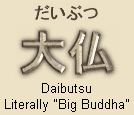  BIG BUDDHA, GREAT BUDDHA = DAIBUTSU 大仏 BIG BUDDHA, GREAT BUDDHA = DAIBUTSU 大仏
Giant Buddha Statues in Japan
Reviews & Photos of 20+ Giant Statues in Japan
Of the three most widely known giant effigies of Buddha from old Japan, only the Kamakura Daibutsu (11.3 meters) remains in original form. The Nara Daibutsu (15 meters) was recast, while the famous Kyoto Daibutsu (24 meters) was entirely destroyed in a fire. All that remains of this once spectacular landmark is a small wooden model.
There are many other Daibutsu statues in Japan. The oldest surviving Daibutsu sculpture in Japan, cast in 609 AD, is the Asuka Daibutsu (2.75 meters). Among stone-carved Daibutsu in Japan, the largest is the Daibutsu of Nihon-ji (31 meters), chiseled into a stone cliff during the 1780s. During the early years of Japanese Buddhism, especially during the Heian Era (794-1185 AD), many Buddhist deities were carved in stone on large rock outcrops, cliffs, or in caves. Known as Magaibutsu or Sekibutsu, these impressive carvings are found nationwide, but over half are located in Kyushu, the earliest inhabited area of Japan. The largest Big Buddha statue in Japan -- and reportedly worldwide -- is the recently constructed 100-meter Ushiku Daibutsu in Ibaraki Prefecture, just 50 km from Tokyo. Finally, dozens of Big Buddha statues have been erected in recent times (post WWII onward). Most of these recent additions were made entirely for commercial reasons (e.g., to increase tourism to certain Japanese localities). Most of these statues are not cataloged herein. For resources on these giant modern effigies, please see the Learn More Section.
|
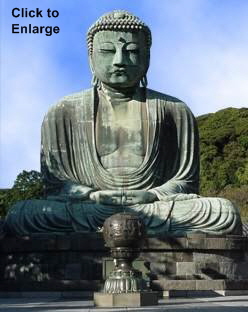
Kamakura Daibutsu
Kamakura Big Buddha
Constructed 1252 AD
Amida Buddha (Nyorai)
Located at Kōtokuin Temple 高徳院 in Kamakura, this giant bronze statue embodies Amida Nyorai. Roughly 11.3 meters in height (13.35 meters with pedestal) and weighing 125 tons, the Kamakura Daibutsu was financed entirely with donations from devotees and commoners (no aid from the imperial court or the Kamakura shogunate). Cast in 1252, the statue was originally housed in a wooden structure, but that structure was destroyed by a violent storm in 1335, rebuilt, and again destroyed in another storm in 1495. Since then, the statue has sat outdoors unprotected from the elements.
Amida (Skt. = Amitābha), which means Infinite Light & Life, is one of the loftiest savior figures in Japanese Buddhism, and Amida faith is concerned primarily with the life to come (paradise). Amida is especially important to Japan’s popular Pure Land (Jōdo 浄土) sects. The key practice for Amida devotees is to chant Amida’s nenbutsu 念仏 (devotional invocation, formulaic prayer), which is Namu Amida Butsu 南無阿弥陀仏 or All Hail Amida Buddha, for Amida vowed that whoever calls his name with faith shall be reborn in his Western Pure Land. Rebirth in this pure land represents a “quick path” to enlightenment. Indeed, belief in Amida’s western paradise underscores the location of the Kamakura Daibutsu -- the statue is located in the western quarter of Kamakura city.
STATUE HISTORY
Yoritomo Minamoto 源頼朝 (1147-1199), famed warrior and founder of the Kamakura shogunate, moved the capital to Kamakura to distance his military regime from meddling by the court and the powerful Buddhist monasteries in Kyoto & Nara. Before his death in 1199, Yoritomo expressed a desire to build a giant Buddha statue in Kamakura, one that could rival the Nara Daibutsu and demonstrate his political power and religious faith. After his death, the Kamakura shogunate was controlled by his wife Hōjō Masako 北条政子 (1157–1225) and a long line of Hōjō regents. Masako approved of plans by Inada-no-Tsubone 稲多野局 (a lady in Yoritomo’s court) to fulfill Yoritomo's wish, but it wasn’t until 1238 that sufficient funds were raised, thanks mostly to monk Jōkō 僧浄光 who (at the request of Inada) had traveled across Japan to solicit donations. The Hōjō regents approved of the project but did not provide monetary support, for the giant statue was to embody Amida Buddha, the central deity of Japan’s Jōdo (Pure Land) sects. The Hōjō regents, however, patronized primarily Zen-sect temples.
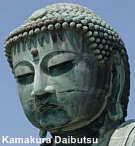  In 1243, construction of the colossal wood statue and a hall to house it were completed, but the statue was destroyed in a violent storm in 1247. Five years later, in 1252, a new statue (this time made of bronze, not wood) was completed, thanks again to fundraising efforts by Lady Inada and Monk Jōkō. A cenotaph stands in the Kōtokuin courtyard to this day to commemorate Lady Inada's tireless dedication to this project. The new statue was cast by Tanji Hisatomo 丹治久友, Ōno Gorō-uemon 大野五郎右衛門, and others. In 1243, construction of the colossal wood statue and a hall to house it were completed, but the statue was destroyed in a violent storm in 1247. Five years later, in 1252, a new statue (this time made of bronze, not wood) was completed, thanks again to fundraising efforts by Lady Inada and Monk Jōkō. A cenotaph stands in the Kōtokuin courtyard to this day to commemorate Lady Inada's tireless dedication to this project. The new statue was cast by Tanji Hisatomo 丹治久友, Ōno Gorō-uemon 大野五郎右衛門, and others.
In 1335, a violent storm swept away the main wooden hall housing the statue (the latter was unharmed), but some 500 samurai, remnants of the then-defeated Hōjō, had entered the building to seek refuge from the storm. They were all crushed to death. A new hall was created thereafter to house the statue.
In 1495, Kōtokuin (Kotokuin) suffered yet again from an earthquake and tsunami wave, and the structure housing the statue was once more destroyed -- but the statue was undamaged. It has sat outdoor, unsheltered from the weather, ever since. In the next two centuries, the statue fell upon hard times and neglect -- at one point in time, gamblers lived inside, making it their hideout. Saddened by the deteriorating condition, a priest from Zōjōji Temple 増上寺 (Jōdo Sect) in Tokyo named Yūten 裕天 (1637-1718) spearheaded a plan to restore the statue and began soliciting contributions in 1712. Some say the statue would have never survived if not for this monk. To commemorate Yūten and other contributors, four bronze lotus pedals were erected & engraved with their names (found today at the rear of the statue).
In 1923, the statue’s base was damaged in the Great Kanto Earthquake and subsequently repaired. In 1960, the statue’s neck and its base were reinforced to help it survive future quakes. Today, you can still climb inside the statue for just 20 yen. But typically no one sits outside collecting money -- it's the honor system. The statue’s face is nearly 2.5 meters long. Upon the head are 656 hair curls. See photos at end of this section.
Says Kondo Takahiro: “A close look at the statues reveals several slight horizontal lines. This tells us that it was a patchwork made with eight pieces of bronze. Even today's technology, however, cannot find out precisely how it was cast and built. The original statue may have been quite different in appearance from what we see today. It was gilt all over and would have been glittering. Over time, the gilt came off, and today you can recognize traces of the original gilt only in the ears. The statue is the only National Treasure in the Kanto region.
Sources on Kamakura Daibutsu:
|
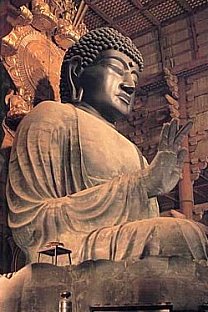
Nara Daibutsu
Nara Big Buddha
Constructed 752 AD
Birushana Buddha (Nyorai)
Located at Tōdaiji Temple 東大寺 in Nara, this bronze statue embodies Birushana Nyorai. Over the centuries, the statue (first cast in 752) has been damaged in various fires, natural disasters, and civil disturbances, but it has always been restored. Its appearance today, however, may not accurately represent its earlier magnificence. In the 9th century, an earthquake knocked off its head. In 1180 and again in 1567, its right hand was melted in accidental fires. The body of the statue was reconstructed in 1185, and the head rebuilt in 1692. At 15 meters (without pedestal) and weighing 250 tons, it is reportedly the largest gilt-bronze effigy in the world. The wooden structure that houses the statue -- the Daibutsuden 大仏殿 (Great Buddha Hall) -- is supposedly the world’s largest wooden building. The present-day hall dates to the early 18th century and is only 66% of its former size. Its rebuilding was completed in 1708 but the repair and replacement of its damaged interior statues was still underway in the 1750s.
Birushana (Skt. = Vairocana) is the main object of worship in the Kegon-kyō 華厳経 (Flower Garland Sutra; Skt. = Avatamsaka Sutra), which is the scriptural authority of Japan’s Kegon sect. The sect’s head temple, then and today, is Tōdaiji, one of Japan’s oldest and most influential temples, one that greatly impacted the early development of Buddhism in Japan. Birushana is also the central deity of Japan’s Tendai and Shingon sects of Esoteric Buddhism (both sects emerged in the early 9th century). Among these two, Birushana is known as Dainichi Nyorai (the Cosmic Buddha, the Great Solar Buddha). Vairocana literally means “belonging to, or coming from, the sunlight.”
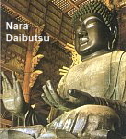  STATUE HISTORY STATUE HISTORY
The Nara Daibutsu was commissioned by Emperor Shōmu 聖武天皇 (701-756) to symbolize the unification of the state and Buddhism under a system known as Chingo Kokka Bukkyō 鎮護国家仏教 (Buddhism for the protection and preservation of the nation). Shōmu is considered one of Japan’s greatest patrons of Buddhism, having ordered the nationwide establishment of provincial temples (kokubunji 国分寺) and nunneries (kokubun-niji 国分尼寺). Each was directly answerable to the center of the country, with Tōdaiji in Nara acting as the head of all state-established temples. Shōmu turned especially to the teachings of the Kegon sect to form the basis of government. One of his great achievements was to order the making of the Nara Daibutsu. Legend contents that Shōmu himself carried buckets of dirt during the construction of the giant image. When it was completed (752), it was considered the largest statue of its kind in the world. Monk Gyōki 行基 (668-749), director of Tōdaiji’s Buddhist community, was instrumental in raising funds for the project.
Another great achievement of Shōmu’s is the Shōsōin 正倉院, a massive treasure-house of art collected by the emperor. The collection (still extant) was donated to Tōdaiji in 756 by Shōmu's widow, Empress Kōmyō 光明. Today, Tōdaiji’s Daibutsuden is still reportedly the largest wooden structure in the world (reconstructed by 1708), some 48 meters in height, 57 in width, and nearly 50 in depth. Tōdaiji also served as the official government ordination platform, where novices & clergy received orthodox (state-approved) ordination as monks or nuns. This allowed the court to limit the number of men & women filling the ranks of the Buddhist clergy.
Shōmu’s embrace of Buddhism also involved the notion of “building spiritual merit” for oneself and others. Known as Chishiki 知識 in Japanese and translated as “pious contribution.” Originally a Sanskrit term (mitra) meaning “friend” or “companion,” in Japan it came to designate any person who spread the Buddhist teachings in hopes of saving others. Chishiki was a means to accumulate spiritual merit and thus improve one’s own chance of salvation. It came in many forms, from those who founded and maintained temples, to those who devoted their money, land, or efforts to advance the cause of Buddhism.
The Chishiki ideal came to prominence with Shōmu, whose giant bronze Buddha statue was financed not only by the state but by the “pious contributions” of devotees, parishioners, and lay people. The “chishiki” ideal meant that the benefits of constructing & maintaining the giant statue would accrue to anyone who participated in the endeavor, no matter how small their contribution. Additionally, the Nara period might rightfully be called the Shōmu Era, for the capital in Nara during his reign (724 to 749) covered about 35 square miles and was home to over one million people. It represented Japan's first real age of imperial splendor.
Says scholar Ross Bender in the PMJS Forum: “The Tamukeyama Hachiman 手向山神社 shrine to the east of Tōdaiji is not as well-known as it might be, but it is home to Tōdaiji’s guardian deity. Although the shrine’s present location dates from 1237, it is the heir of the shrine built when the Shinto deity Hachiman came to Nara in 757 AD.
Sources on Nara Daibutsu:
|
|
PHOTOS OF KAMAKURA’S GREAT BUDDHA (AMIDA)
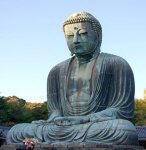 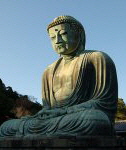 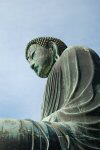 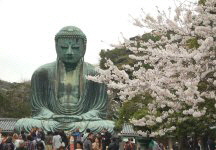
Great Buddha of Kamakura (Kamakura Daibutsu) -- an effigy of Amida Nyorai.
Click images to enlarge. All photos by Mark Schumacher.
|
|

 KYOTO DAIBUTSU KYOTO DAIBUTSU
The 24-meter-high Kyoto Daibutsu (no longer extant) of Hōkōji Temple 方広寺 was built during the reign of Toyotomi Hideyoshi 豊臣秀吉 (1536-1598). Toyotomi founded this Tendai-sect temple and ordered the creation of its giant monument to honor the spirit of his dead mother and his ancestors. After his own death it became the Toyotomi mortuary temple. Construction of the giant statue reportedly took only three years (as compared to 20 years for the Nara Daibutsu). The wood image was made by noted sculpture Kōshō 康正 (1534-1621), the head of the Shichijō Bussho 七条仏所 (Seventh Avenue Atelier), a major sculpting workshop of the Keiha school located in Kyoto. However, the statue was destroyed by an earthquake soon after its completion in 1596. Another statue was soon commissioned, this time in bronze, but it was destroyed in an accidental fire during the casting process in 1602. A third effigy was commissioned between 1609 and 1616, but it was ruined in another natural disaster in 1622. A fourth statue, this time made of wood, was created in 1664 by the Buddhist sculpture Genshin 玄信 (active mid-17th century, part of Kōshō’s lineage). It was destroyed by lightning in 1789. All that remains of this once spectacular landmark is a small wooden maquette (hinagata 雛形) attributed to Genshin. <Note: Tokyo National Museum attributes the maquette to sculptor Fujimura Chūen 藤村忠円, a student of Genshin. But research by Chō Yōichi (published in TNM’s own journal, #554, June 1998) explains why Genshin is the likely creator.>
KYOTO DAIBUTSU
Says scholar Beatrice M. Bodart-Bailey in A Song for the Shogun: Engelbert Kaempfer and 17th-c. Japan: “The only detailed pictorial record of the Kyoto Daibutsu is from the drawings of the German physician Engelbert Kaempfer (1651-1712), who stayed in Japan from 1690 to 1692. In his writings, he noted the particulars, from the ’long bovine ears’ and the ’frizzy hair’ to the fact that there would be space enough for three Japanese mats on its outstretched palm. He measured out the distances for a more detailed record, and noted that the width between the shoulders was equivalent to fifteen paces.” (Site Editor: The effigy he witnessed must have been the statue built in 1664)
Says scholar Jens Hvass in a 1999 seminar at Hokkaido Tokai University 北海道東海大学 (merged into Tokai University in April 2008): “Through the centuries Japanese Buddhism has produced a series of large-scale monuments. Take for instance the big Buddha figures. The Daibutsu at Tōdai-ji in Nara was inaugurated in 752 as a symbol of Buddhism rising to the role of national religion. And thus it represents the integration of the mundane power structure and the Buddhist institution - a symbiosis that with certain changes on the way would last for the following 1200 years. The second big Buddha figure was inaugurated in Kamakura in 1252. It served the purpose of legitimating that actual power could be executed from Kamakura. The third big Buddha figure was erected in Kyoto in the late 16th century by the big upstart in Japanese history, Toyotomi Hideyoshi (1537-98). It was even bigger than its two predecessors were, and by that time in Japanese history, legitimization through architectural manifestations seems to have become an unquestionable necessity of power positions.” |
|

|
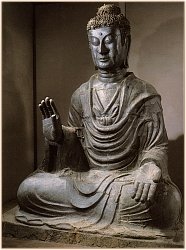  The Asuka Daibutsu The Asuka Daibutsu
One for the History Books, Constructed +609
Asuka Dera 飛鳥寺 (near Nara) is generally regarded as Japan's oldest temple. Built sometime around +588 and +596, the temple is also known as Gangōji 元興寺, Angoin 安居院, Hon-gangōji 本元興寺, and Hōkōji 法興寺.
The temple houses what is claimed to be the oldest Daibutsu (Big Buddha) statue in Japan. The Asuka Daibutsu is at least one century older than the Birushana Daibutsu at Todai-ji Temple in Nara. Despite repairs and alterations, the statue's facial features and hands are still the originals. The Asuka Daibutsu is said to be a work of Kuratsukuri no Tori 鞍作止利, a noted sculptor of those days whose family immigrated to Japan from China (some sources say Korea). The seated Asuka Daibutsu sculpture is 275.2 cm (2.75 meters) in height, and is designated as an important cultural asset.
 CONTROVERSY. According to tradition, Buddhism was introduced to Japan in +538 (some say +552) when the king of Korean sent the Japanese court a small bronze Buddha statue, some Buddhist scriptures, and a message praising Buddhism (none of these early artifacts have survived). Most scholars believe it was the king of Kudara 百済 (aka Paekche, Paekje, Paikche, Baekje), a kingdom in Korea, who presented these gifts to the Japanese court then located in the Asuka region. Legend contents that the bronze statue was entrusted to the leader of the Soga 蘇我 clan, who acted as the chancellor of the young Japanese nation. But soon thereafter an outbreak of smallpox occurred, and clans opposed to Soga influence and Buddhism’s introduction claimed the statue was responsible for the sickness afflicting Japan. The emperor, hoping to diffuse the situation, ordered the statue thrown into the Naniwa River, near the court’s palace in current-day Osaka City. The statue was, according to legend, thereupon pitched into the river. The discarded statue, it is said, was later fished out of the river following the victory of the Soga clan, and is still, to this day, installed at Asuka Dera. This legend is incorrect, for the extant statue installed at Asuka Dera was cast around +609, and is much too large to be the legendary “first” Buddha statue to arrive in Japan. Perhaps the extant statue is a giant copy of that first small Buddha statue? This latter issue has never been resolved. CONTROVERSY. According to tradition, Buddhism was introduced to Japan in +538 (some say +552) when the king of Korean sent the Japanese court a small bronze Buddha statue, some Buddhist scriptures, and a message praising Buddhism (none of these early artifacts have survived). Most scholars believe it was the king of Kudara 百済 (aka Paekche, Paekje, Paikche, Baekje), a kingdom in Korea, who presented these gifts to the Japanese court then located in the Asuka region. Legend contents that the bronze statue was entrusted to the leader of the Soga 蘇我 clan, who acted as the chancellor of the young Japanese nation. But soon thereafter an outbreak of smallpox occurred, and clans opposed to Soga influence and Buddhism’s introduction claimed the statue was responsible for the sickness afflicting Japan. The emperor, hoping to diffuse the situation, ordered the statue thrown into the Naniwa River, near the court’s palace in current-day Osaka City. The statue was, according to legend, thereupon pitched into the river. The discarded statue, it is said, was later fished out of the river following the victory of the Soga clan, and is still, to this day, installed at Asuka Dera. This legend is incorrect, for the extant statue installed at Asuka Dera was cast around +609, and is much too large to be the legendary “first” Buddha statue to arrive in Japan. Perhaps the extant statue is a giant copy of that first small Buddha statue? This latter issue has never been resolved.
WHAT BUDDHA DOES THE
ASUKA DAIBUTSU REPRESENT?
1. Yakushi Nyorai, the Medicine/Healing Buddha
Says the Nara Prefecture Official Site: “Established in +596 by Soga-no-Umako 蘇我馬子 (an enthusiastic supporter of Buddhism in Japan), Asuka-dera (also called Asuka Temple) is mentioned in old reports as being three times as large as Horyu-ji Temple (the Asuka Historical Museum says it was 200 meters on each side). Such a gigantic temple reminds us of the powerful Soga 蘇我 clan of the times. Yakushi Nyorai, otherwise known as Asuka Daibutsu, a divine savior said to relieve people's present agony, is the earliest large-sized Buddha statue in Japan, and is designated as an important cultural asset.
- Asuka Dera TEL: 0744-54-2126
- Hours: 9:00 - 17:15 (or 9:00 - 16:45 from Oct. to March )
- Open 7 days a week
2. Shaka Buddha, the Historical Buddha
Says the JAANUS Database: “The Asuka Daibutsu 飛鳥大仏 is a bronze statue 2 m 75 cm high, thought to represent Shaka Buddha 釈迦 (the Historical Buddha). It is the oldest surviving Buddhist statue in Japan today, estimated to have been completed in the year +609. Temple legend says that the sculptor was the famous Kuratsukuri no Tori 鞍作止利. The statue sits on a stone pedestal in the cross legged posture known as kekkafuza 結跏趺坐 (outside link).”
Says the Asuka Historical Museum. “The Asuka Daibutsu was the main object of worship (honzon 本尊) in the Asuka Dera's original Chu-Kondo (central main hall). It was cast in +609, in the 17th year of Empress Suiko's reign, by the master Busshi 仏師 (Buddhist sculptor) known as Kuratsukuri no Tori 鞍作止利 (aka Tori Busshi), son of a Korean immigrant (Editor’s Note: Most scholars disagree. Most say Tori’s family immigrated from China, not Korea). It is the oldest extant Buddhist image in Japan whose date of construction is definitely known. Repairs and alterations from later times are clearly in evidence, but in such features as the elongated face and the shape of the eyes may be seen the original characteristics of the Tori-shiki 止利式 (Tori style) of Buddhist imagery shared also by the Shaka Triad at the Horyu-ji Temple. The granite base is original, as are the socketed stands (hozoana) presently placed on either side and serving to support the flanking attendant figures. Comparing the Asuka Daibutsu with the Horyu-ji Shaka triad, one is reminded of the power possessed by the Soga 蘇我 family, who were able to commission the building of a Jōroku-zō, or what was considered to be a full-scale image, one jo and six shaku (or about 4.8 meters) high, several times larger than the central figure of the Horyuji triad. Thus, if the sitting statue of the Asuka Daibutsu could stand up, the statue would be about five meters tall.”
- ADDRESS OF ASUKA DERA
682 Asuka, Asuka-mura, Takaichi-gun, Nara-ken, Japan
Tel. 0744-54-2126
- LEARN MORE ABOUT ASUKA DERA - EXTERNAL LINK
Asukadera - A Battered Buddha. by Ad G. Blankestijn
- Jōroku 丈六 (Jouroku, Joroku)
One jo and six shaku (about 4.8 meters)
Jo-roku (or joroku) is equivalent to roughly 4.8 meters. Many “standing” sculptures in the early years of Japanese Buddhism are made to this specification. Jo is a unit of length, about three meters, and Roku means “six,” and this refers to six shaku (shaku is another Japanese unit of length, about 0.30 meters). Thus, Jo-roku is equivalent to roughly 4.8 meters. Actually, if the sitting statue of the Asuka Daibutsu could stand up, it would be taller than five meters.
|
|

|
NIHON-JI DAIBUTSU
Image of Yakushi Rurikō 薬師瑠璃光 (aka Yakushi Buddha)
The Big Buddha at Nihon-ji Temple in Chiba Prefecture is a representation of Yakushi Nyorai (the Medicine Buddha, the Buddha of Healing). This stone-cliff Buddha (magaibutsu) is 31.05 meters in height. It, plus 1,500 smaller statues in the area, were carved by master artisan Jingoro Eirei Ono and his 27 apprentices in the 1780s and 1790s. This Daibutsu of Yakushi Nyorai is twice the size of the Kamakura Daibutsu and Nara Daibutsu, making it the largest of pre-modern Japan’s extant Big Buddha statues. The Nihon-ji Temple itself dates back to 725 AD.
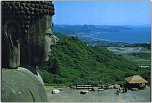 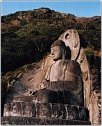 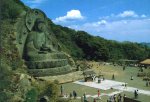
Above Three Photos by Photographer Goto Osami
Click any image above to see a larger photo.
Gohyaku Rakan 五百羅漢
At the same location, one can find carvings of 500 Rakan (Arhat) (a grouping known as the “Gohyaku Rakan” in Japan), as well as a gigantic stone carving of the Kannon Bosatsu called the “Hyaku Shaku Kannon.” The Rakan images took 20 years to carve. The project, attributed to the 15th chief priest of Nihon-ji, also occurred during the latter half of the Edo Period. All of these carvings are located at Mt. Nokogiri-yama. The literal meaning of this mountain’s name is “saw mountain,” for its shape looks like the teeth of a saw.
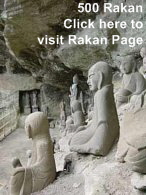 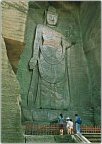 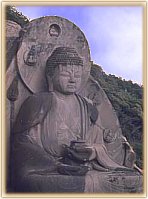
(L) 500 Arhats; (M) Kannon Bosatsu (R) Yakushi Nyorai
More Photos of Nihon-ji Daibutsu
-- www.town.kyonan.chiba.jp/nokogiriyama/nokogiriyama.htm
-- www.vt.sakura.ne.jp/~grgr56/goro/wtemple/wtem0p32.html
-- http://arruku.hp.infoseek.co.jp/01bousou/nokogiri.html

 Shōwa Daibutsu (Aomori) Shōwa Daibutsu (Aomori)
Dainichi Buddha Daibutsu
Bronze, H = 21.35 Meters
Weight = 220 tons
Built in 1984 (Shōwa 59), the Shōwa Daibutsu is a giant effigy of Dainichi Nyorai, the central deity of worship among Japan’s Shingon sect of Esoteric Buddhism. Located at Seiryū-ji 青龍寺 (Blue-Green Dragon Temple) in Aomori City, the statue is taller than the Nara Daibutsu and Kamakura Daibutsu . The temple itself is new, with construction launched in 1982.
Seiryū-ji Temple 青龍寺
Aomori Prefecture
Aomori City
TEL: 017-726-2312
FAX: 017-726-2124
Like many Shingon temples throughout Japan, Seiryū-ji holds special light ceremonies during the Bon Festival (mid-August) to pray for the response of ancestors, dead children, and the transmigration of their departed souls. Indeed, there are many sites in Aomori Prefecture where grieving parents go to to pray and make offerings to pacify the soul of their lost child and to pacify their own soul as well. Details Here.
One of the most popular lighting ceremonies is the “Festival of Ten Thousand Lights” held during the Bon holidays. Details Here. Seiryū-ji Temple follows this tradition by holding Buddhist services for the dead and lighting ceremonies during the Bon period.

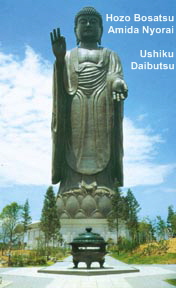  Ushiku Daibutsu Ushiku Daibutsu
aka Hōzō Bosatsu / Amida Nyorai
100 meters in height
Ibaraki Prefecture, 50 km northeast of Tokyo. Originally known as Jōdo Teien, this garden park is now referred to as Ushiku Arcadia, a place to retrace the journey of Hōzō Bosatsu (法蔵菩薩, also spelled Houzou or Hozo). Hōzō (Skt. = Dharmakāra) appears in the Sutra of Infinite Life (Muryōjukyō 無量壽經; Skt. Sukhavatiyuha Sutra). As a human, Hōzō was a king who gave up his throne after hearing the teachings of Lokesvararaja Buddha (Sejizaiō Butsu 自在王佛). He became a monk, and after eons of practice, he became Dharmakāra Bodhisattva (Hōzō Bosatsu 法藏菩薩), who then made 48 vows, fulfilled them, and became Amida Nyorai. The Ushiku Daibutsu (not sure of exact construction date; perhaps 1995 AD) is reportedly the tallest Buddhist statue in the world. One hundred meters in height, it is covered with 6-mm-thick bronze plates, and stands on a platform 20 meters high. The statue is more than double the height of the Statue of Liberty. Above photo courtesy origin.sundayobserver.lk. For a chart of the statue’s size, see daibutu.net/daibutu.html (J-site)
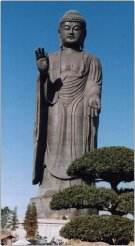 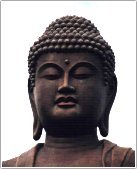 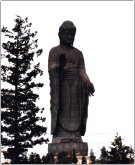
Above Three Photos by Photographer Goto Osami.
Click any image to see a larger photo.

Takaoka Daibutsu, Takaoka City, Toyama Prefecture
Abridged translation of Yomiuri Shimbun Story, Sept. 23, 2004
This sitting image of the Buddha is 7.4 meters high. If the pedestal is included, the statue is 15.9 meters in height. The original burnt to the ground numerous times during its history. Construction on this particular reproduction began in 1907, and was completed in 1933. The ground beneath the statue gave way in 1980, sinking about 11 meters, so the statue was moved to its current location and repairs yet again undertaken. According to records, the first Big Buddha in Takaoka was built of wood in the Kamakura era, but was lost to fire. The current metal statue was built thanks to the ceaseless efforts of Matsukisōzaemon 松木宗左衛門. The Big Buddha of Nara and Kamakura, plus the Takaoka Daibutsu, are sometimes referred to as Japan's Three Great Buddha 日本三大大仏.

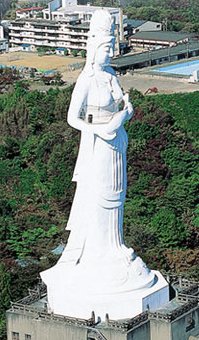  Big Kannon (Dai Kannon) Big Kannon (Dai Kannon)
Kamaishi Daikannon, 釜石大観音
Height = 48.5 meters.
Kamaishi City, Iwate Prefecture. Built in 1970 to attract more tourists to the area, this statue of Kannon symbolizes maritime safety and good fishing. The statue, a modern version of the Gyoran Kannon 魚籃観音 (Kannon with Fish Basket), holds a large fish in its hands. Gyoran Kannon is one of the 33 incarnations of Kannon Bosatsu, and is typically shown holding a fishing basket. This modern statue, however, shows her holding a fish. Visitors can climb inside the 13-story statue (with 204 stairs) and enjoy various galleries of Buddhist art and scenic vistas of the surrounding bay area. Kamaishi City was Japan's first municipality to pursue manufacturing with iron blast furnaces -- the town's name 釜石 literally means "Iron Town."
Says site contributor Gabi Greve: “Originally a girl of T'ang China, who was selling fish on the market. She asked Kannon Bosatsu to grant her a good husband. The wish was granted, and later the girl herself was considered an incarnation of Kannon Bosatsu. This form of Kannon (#10 out of 33) is now, in this area, considered the deity of young men looking for wives.” TEMPLE TELEPHONE: 0193-24-2125, Open 9 to 17 pm
External Links:

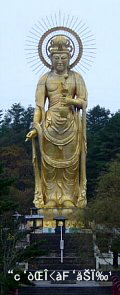  Kannon Bosatsu Kannon Bosatsu
Big Golden Kannon, 35 Meters in Height
Akita Prefecture, next to the Hotel Tazawa in Tazawa-cho City. Not sure when this gaudy statue was built (the grounds were closed when I visited), but I would guess sometime during Japan’s bubble economy in the early 1990s. I was not impressed whatsoever by this statue or by the complex surrounding it. The general mood here is shamelessly commercial -- it costs 1000 yen just to enter the grounds. At the entrance are two large modern reproductions of the NIO guardians, both lacking in grace or artistry, and looking as though forged from plastic. The complex was no doubt built to attract more tourists to the Tazawa area, which is famous for its many natural hot springs. For details on Kannon Bosatsu, click here.

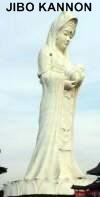  Jibo Kannon | 慈母観音 | Lit. “Loving Mother” Jibo Kannon | 慈母観音 | Lit. “Loving Mother”
57 meters in Height
Jibo Kannon in Kawahigashi Town, Aizumura
Photo by www.virtualtourist.com/vt/58c/4/
Visitors can go inside this statue. At this location, one will also find a 14-meter reclining statue of the Buddha and an enormous Japanese garden. The Goddess of Mercy, aka Kannon, appears in numerous manifestations. Three of her forms are especially related to motherhood, easy delivery, and child-rearing. They are Koyasu Kannon (child-giving Kannon), Jibo Kannon (loving-mother Kannon), and Juntei Kannon (mother-of-the-Buddhas Kannon).

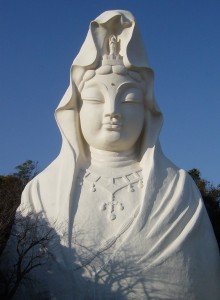  Ofuna’s White-Robed Kannon Ofuna’s White-Robed Kannon
HEIGHT = 29.39 meters
Byakue Kannon 白衣観音
Byakushozon 白処尊
Byakue Kanjizaimo 白衣観自在母
Panduravasini (Sanskrit)
Ofuna, Japan. Work on this statue began in 1934, but the outbreak of the second world war halted construction, which began again after the war, and was completed in 1961. The complex here contains stones from ground zero at Hiroshima and Nagasaki, as this temple commemorates the souls of those who died in the atomic bomb attacks, and prays for permanent world peace. The temple holds a festival each September. DIRECTIONS: Just outside Ofuna Station (near Kamakura City on the Yokosuka train line or Tokaido train line). Only one hour from Tokyo.

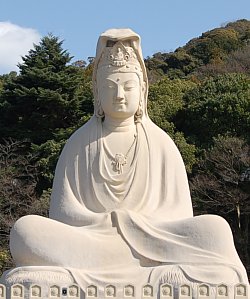  Ryōzen Kannon 霊山観音 Ryōzen Kannon 霊山観音
HEIGHT = 24 meters
An image of the White Robed Kannon, Byakue Kannon 白衣観音, Byakushozon 白処尊, Byakue Kanjizaimo 白衣観自在母, Panduravasini (Sanskrit)
Kyoto, Japan. Made with 500 tons of concrete with steel-rod frames, this giant effigy of Kannon was unveiled in 1955 to commemorate the soldiers who died in World War II and to pray for a peaceful Japan. The memorial’s own brochure is entitled “A Tribute to The Unknown Soldier, World War II.”
Made by famous Showa-era sculptor Yamazaki Chōun 山崎朝雲 (1867 - 1954)

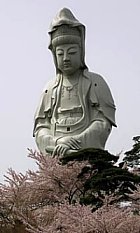 Byakue Kannon Byakue Kannon
White-Robed Kannon
白衣観音、慈眼院
Takasaki City, Gifu
Constructed in 1936.
This standing image of
Kannon is 41.8 meters
in height.
PHOTO CREDIT:
Byakue Kannon (J-site link)
White Robed Kannon

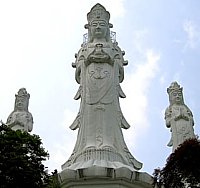  Torii Kannon Torii Kannon
鳥居観音、白雲山鳥居観音
Saitama Prefecture, Hannou City. Constructed in 1971. This standing Kannon statue is 35 meters in height (without the pedestal, it is 23 meters high). Visitors can climb a narrow spiral staircase inside the statue that reaches the head piece.
Photo courtesy this J-Site:
www.toriikannon.org

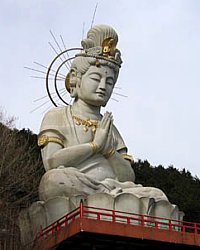  Usami Kannon Usami Kannon
宇佐美観音
Photo from this J-site
This 50-meter high sitting statue of the Kannon (built to pray for global peace) was constructed in 1982. Located in Shizuoka Prefecture, Ito City, in the tiny town of Usami. The Kannon sits on a hill above the town. Reportedly the largest sitting statue of Kannon in Japan. The temple grounds hold a broad array of statues, including those from Tibet and Nepal, numerous mandala, and statues of the Seven Lucky Gods. Some web sites claim it is the Jibo Kannon 慈母 (Loving Mother Kannon), but I have yet to confirm this. Strangely, the temple’s own web site fails to give the year of construction or the identity of the Kannon.

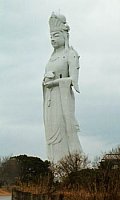  Tokyo Bay Kannon Tokyo Bay Kannon
東京湾観音、千葉県富津市
Located in Futtsu City, Chiba Prefecture. Constructed in 1961. 56-meters in height. A standing statue of Kannon, erected in memory of the war dead by a private donor. Visitors can climb up 314 steps inside the statue.
Inside the statue's crown is a power system for lighting 10,000 candles (for the Festival of Ten Thousand Lights, held during the August Obon season). Photo courtesy this J-Site.

 Byakue Kannon Byakue Kannon
White-Robed Kannon
北海道大観音
Ashibetsu City, Hokkaido
Reportedly the world’s tallest statue of Kannon, this 88-meter effigy of the Goddess of Mercy was built in 1989 (Heisei 1). It is the centerpiece of a large theme park called Kita no Miyako 北の京 ("Capital of the North") that features a water park, spas, and a large hotel designed to match the style of the famous Sanjusangen-do (Hall of 33 Bays) in Kyoto.
Visitors can enter the statue and worship at eight places located between the 6th floor and 20th floor. There is also a lookout platform near the top. In the same vicinity is the Juuni Shi Shrine/Temple complex, where the Shinto guardian deities of the 12 zodiac signs are worshipped, with the central hall devoted to Imperial Prince Shoutoku Taishi, the patron of Early Buddhism in Japan.
Photos courtesy this J-site and this J-site. Photos of the rooms and worship places inside the statue can be seen here. Statue located at Ashibestsu City, Hokkaido 北海道 芦別市
TEL (01242) 2-3661 and FAX (01242) 2-3995.

 Sitting Byakue Kannon Sitting Byakue Kannon
White-Robed Kannon
百尺観音
26.4 meters in height.
Fukushima Prefecture
Near Soma City, 相馬市、福島県
Sitting image of the Goddess of Mercy, carved into a stone cliff. Construction of the statue was begun in 1930 by Busshi Yoshiaki Ara 仏師荒嘉明 (あらよしあき). Busshi is a Japanese term that literally means “Buddhist Teacher,” but it is used as an honorific title for those who carve Buddhist statues.
Monk Yoshioka, a local from the Soma area, died in 1963 at the age of 62 without having finished the statue. Work was continued by a 2nd-generation sculpture, who died in 1978 at the age of 53. Today, a 3rd-generation master sculptor named Mr. Yoshimichi continues work on the incomplete statue.
For more photos, please visit this J-Site. Scroll down that page to find the photos.

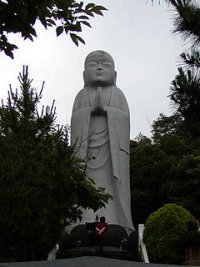 Big Jizo Statue Big Jizo Statue
大地蔵
Niigata Prefecture
Sado Island, Ogi Town
新潟県小木町
17.5 Meters in Height.
Made of Concrete.
Located near
Mt. Iwayasan (Wayasan)
岩谷山
Photo Courtesy This J-Site
|
|

|
MAGAIBUTSU 磨崖仏 (まがいぶつ)
Images Carved in Cliffs, Large Rock Outcrops, or in Caves
BACKGROUND NOTES, KUNISAKI PENINSULA ON KYUSHU ISLAND
From the Heian Period (794-1185 AD) through the Kamakura Period (1185 to 1333 AD), the Kunisaki Peninsula in Kyushu thrived as a great hub of Buddhist culture in Japan. Countless stone statues, many carved into cliffs, still survive into the present day. This area is reported to contain more than 60% of Japan’s magaibutsu (Buddhist images carved on large rock outcrops, cliffs, or in caves) and sekibutsu (free-standing, movable statues carved from stone). Kyushu is credited as the source of Japanese civilization, from which the seeds of culture were planted throughout the islands. Archaeological findings suggest that Kyushu was the earliest inhabited area of Japan, and historical records show that first contact with mainland Asia originated in Kyushu.
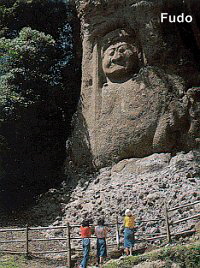  KUMANO MAGAIBUTSU KUMANO MAGAIBUTSU
熊野磨崖仏 - くまのまがいぶつ
Two deities, Fudo Myo-o and Dainichi Nyorai, are carved on a cliff behind Taizo Temple in Tashibu, Oita Prefecture. For more on Kumano and the early spread of Buddhism in this area, see the Pilgrimage Guide. The Dainichi image is six meters high and the Fudo image eight meters. Thought to be Japan’s largest and oldest cliff carvings, they first appear in official court records in 1228 AD, but the actual date of their construction is clouded in uncertainty. Many believe construction occurred sometime in the Heian Era. The many steps leading up to the carvings, according to legend, were built by demons. Engraved on the head of the Dainichi image is a three-phased mandala, reportedly the only surviving example in Japan, and one said to be intimately related to the Shugendo sect of Esoteric Buddhism. <Above photo courtesy of www.oita.isp.ntt-west.co.jp/WNN-C/ENGLISH/kunisaki.htm; text adapted from city.bungotakada.com>
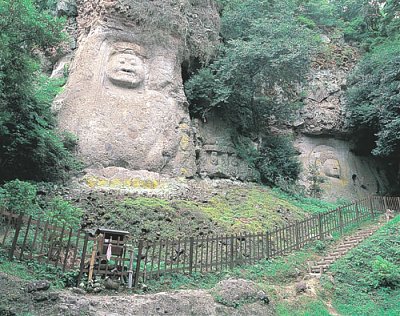
Kumano Magaibutsu - Fudo at left, Dainichi at right
Photo: city.bungotakada.com

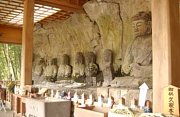  USUKI MAGAIBUTSU USUKI MAGAIBUTSU
臼杵石仏 -- うすきせきぶつ
www.cvl.iis.u-tokyo.ac.jp/gallery_e/usuki-hp/usuki.htm
Fukata, Usuki City, Oita Prefecture
The Stone Buddhas near Usuki City, located in the western island of Kyushu, were designated as National Treasures in April, 1995, the first stone Buddhas to be named as such. They are called "Usuki Magaibutsu," and consist of dozens of individual carvings. These images were sculpted on soft cliffs made from lava or sand stone that abound in this area. Historians say that they were carved during the 12th to 14th centuries.
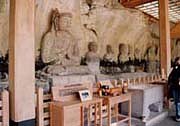  USUKI MAGAIBUTSU USUKI MAGAIBUTSU
臼杵石仏 -- うすきせきぶつ
www.fudosama.blogspot.com/2006/06/magaibutsu.html
Oita has a wealth of Buddhist figures carved into mountainsides and sculpted from stone. The many carvings in the mountainside in the area of Usuki City (the Usuki Magaibutsu) are a National Treasure. The immense Kumano figures (Kumano Magaibutsu; see above entry) are also famous, and the 3,770 stone images at the Rakan-ji Temple (Nakatsu) attract much attention. This area was famous for Magaibutsu since the late Heian period. Three medallions of the Kamakura period are visible on the cliff face.
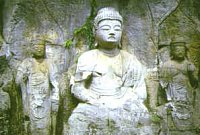 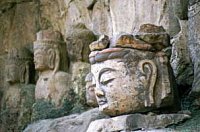
Usuki Magaibutsu, photos courtesy of:
http://www1.kcn.ne.jp/%7Eyosikatu/

25 BOSATSU AND JIZO BOSATSU (Nice Photo Slide Show)
Stone Buddhas in Moto-Hakone 元箱根の石仏 (Near Mt. Fuji)
Reportedly constructed around 1295 AD.
www1.kcn.ne.jp/%7Eyosikatu/hakone.htm
www1.kcn.ne.jp/%7Eyosikatu/hakone/rokudou01.htm
UDONO SEKIBUTSU, Ochi Town, Saga Prefecture
The Udono Sekibutsu include 58 images of Buddha that were carved into the sandstone walls over 1,000 years ago.
LEARN MORE ABOUT MAGAIBUTSU STOVE CARVINGS
- www1.kcn.ne.jp/%7Eyosikatu/ (J; Nationwide Index)
- www.we-love-oita.or.jp/kankou/english/e2/e2_7/eisibunka.html (E)
- www.fudosama.blogspot.com/2006/06/magaibutsu.html (E)
- www.cvl.iis.u-tokyo.ac.jp/gallery_e/usuki-hp/usuki.htm (E)
- www.oita.isp.ntt-west.co.jp/emati/english/skbt/usuki_e.html (E)
- INDIA. http://jan.ucc.nau.edu/%7Ejsa3/362/362.html
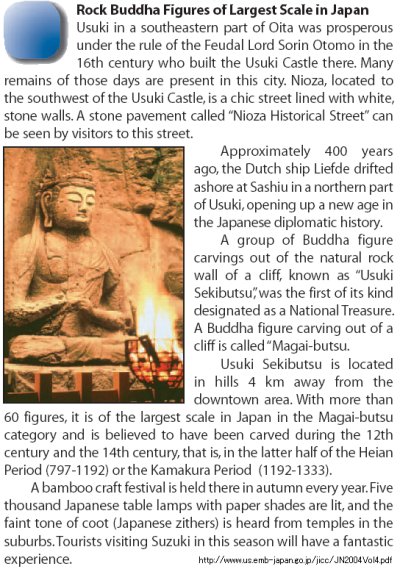
|
|

|
Sekibutsu 石仏 (Stone Carvings of Buddhist Deities)
Courtesy of JAANUS (excellent dictionary of Buddhist concepts)
www.aisf.or.jp/~jaanus/deta/s/sekibutsu.htm
www.aisf.or.jp/~jaanus/deta/m/magaibutsu.htm
Sekibutsu literally means “Stone Buddha.” A Buddhist image made in rock or stone. The term sekizou 石造 or "carving from stone" was used to indicate the material of a sculptured work. Sekibutsu were divided broadly into two groups:
- Magaibutsu 磨崖仏, also written 摩崖仏. Also known as magai sekibutsu 磨崖石仏 or 摩崖石仏. Buddhist images carved on large rock outcrops, cliffs, or in caves. Caves carved with Buddhist images which were large enough for people to enter and used as temples were specifically called sekkutsu jiin 石窟寺院 (cave temple). The rock-face was first polished, and then the image was created with engraved lines (senkoku 線刻) in low relief (ukibori 浮彫) or in high relief (takanikubori 高肉彫). Clay was used to model details on the relief carving. Occasionally colors and gold leaf were applied. The surrounding rock was often hollowed out to form an alcove for the figure, so a deeply carved magaibutsu was sometimes known as butsugan 仏龕, meaning 'Buddha alcove' and a cave temple large enough for people to enter was often referred to as sekkutsu jiin 石窟寺院 or sekkutsuji 石窟寺. Rock carving flourished in the Han, and Northern and Southern dynasties in China (1th to 6th centuries AD) as well as in India, Afghanistan, and Korea. In Japan, magaibutsu never formed the mainstream of Buddhist sculpture, but there are many surviving examples dating from the 7th to 14th century AD. It has been pointed out that popular Shinto belief in the living spirit of rocks in Japan was combined with Buddhism and was expressed in magaibutsu. Examples can be found across the country, but Kyuushuu has the greatest concentration of rock carvings, including the famous stone Buddhas in Usuki 臼杵 (Ooita prefecture; 11-12c). The images were carved on soft rock such as tuff, a rock formed by the consolidation of volcanic ash and tufa, a porous calcium carbonate rock found around mineral springs. The late Heian period was regarded as the peak of the magaibutsu in Japan. Kamakura-era works were smaller in size, carved on hard stone such as granite, and often unpainted, leaving the natural stone surface. After the 14th century, free-standing stone Buddhas (sekibutsu 石仏) became more popular, and fewer magaibutsu were made.
- A free-standing, movable statue carved from stone. Carving a work from a single block of stone was called isseki-zukuri 一石造. Sometimes a single figure or group statue was carved out of a single block of stone, but sometimes several blocks were joined. Stone was the chief material used for Buddhist images in China and India, whilst in Japan stone statues have never challenged the dominance of wood and bronze because appropriate stone materials were not so readily available. Neverthless, examples dating from the 7c on can be found over a very wide area of the country. Mainly soft rocks such as tuff (consolidated volcanic ash) and tufa (porous calcium carbonate rock) were used until the 12c, but thereafter hard rocks such as granite came to be used. The oldest known sekibutsu in Japan is the Buddha triad (sansonzou 三尊像) in Ishiidera 石位寺 (Nara ; late 7c); the central figure and two attendants were carved out of a single block of stone in an intermediate level of relief (hannikubori 半肉彫). Another well-known example is the 8c bodhisattva (*bosatsu 菩薩) group called Zutou 頭塔 (Nara); 13 figures were carved in low relief (*usunikubori 薄肉彫)on a single stone block. There are a few other examples dating from the 9c in the Nara area, and after the 10c large-scale rock and cliff carvings were produced over a very wide area of Japan. Famous examples of magaibutsu include those in Usuki 臼杵 (Ooita prefecture; 11c-12c), Ooya 大谷 (Tochigi prefecture.; 11c-12c), Izumisawa 泉沢 (Fukushima prefecture) as well as the Fudou 不動 at Nissekiji 日石寺 (Toyama prefecture.; 12c). It is speculated that stone statues suddenly became popular because their durable quality suited the mood of the "end of the world" belief (mappou shisou 末法思想) prevalent in the 10th to early11c. The 13c production of sekibutsu once again focused sculpture production on much smaller-scale works, and with the exception of the group stone carvings at Hakone 箱根 (Kanagawa prefecture.) no magaibutsu carvings were produced. However, numerous, small-scale free-standing stone statues related to regional popular faith, such as *Jizou 地蔵, *Shoumen Kongou 青面金剛, or local Shinto deities (see *Shintou bijutsu 神道美術), were produced and placed at the outskirts of a village to ward off evil and sickness. Many such statues can still be seen today on roadsides.
|
|

|
The Buddha at Kamakura
"And there is a Japanese idol at Kamakura"
by Rudyard Kipling
O ye who tread the Narrow Way
By Tophet-flare to Judgment Day,
Be gentle when the 'heathen' pray
To Buddha at Kamakura!
To him the Way, the Law, apart,
Whom Maya held beneath her heart,
Ananda's Lord, the Bodhisat,
The Buddha of Kamakura.
For though he neither burns nor sees,
Nor hears ye thank your Deities,
Ye have not sinned with such as these,
His children at Kamakura.
Yet spare us still the Western joke
When joss-sticks turn to scented smoke
The little sins of little folk
That worship at Kamakura.
The grey-robed, gay-sashed butterflies
That flit beneath the Master's eyes.
He is beyond the Mysteries
But loves them at Kamakura.
And whoso will, from Pride released,
Contemning neither creed nor priest,
May feel the Soul of all the East
About him at Kamakura.
Yea, every tale Ananda heard,
Of birth as fish or beast or bird,
While yet in lives the Master stirred,
The warm wind brings Kamakura.
Till drowsy eyelids seem to see
A-flower 'neath her golden htee
The Shwe-Dagon flare easterly
From Burmah to Kamakura,
And down the loaded air there comes
The thunder of Thibetan drums,
And droned -- "Om mane padme hums" --
A world's-width from Kamakura.
Yet Brahmans rule Benares still,
Buddh-Gaya's ruins pit the hill,
And beef-fed zealots threaten ill
To Buddha and Kamakura.
A tourist-show, a legend told,
A rusting bulk of bronze and gold,
So much, and scarce so much, ye hold
The meaning of Kamakura?
But when the morning prayer is prayed,
Think, ere ye pass to strife and trade,
Is God in human image made
No nearer than Kamakura?
-- Rudyard Kipling

** NOTES ON ABOVE KIPLING POEM
Courtesy www.cs.rice.edu/~ssiyer/minstrels/poems/379.html
- Narrow Way is a reference to Christianity, which contrasts to the “Eight-fold Path” of Buddhism and the ”Middle Way” of Confucianism.
- Tophet is a place in a valley southwest of Jerusalem. Also the name of the Moloch Shrine (on that spot) where parents sacrificed their children. Also a generic name for a place of child sacrifice or the burial of sacrificial victims (as in Carthage). There is a brief reference to Tophet in the Columbia Encyclopedia (1950 edition).
- Maya was the mother of Gautama (the Historical Buddha)
- Ananda is the faithful chela (disciple) who features in many tales of the Historical Buddha.
- Bodhisat (Sanskrit Bodhisattva, Japanese Bosatsu) is a soul who reaches enlightenment and then devotes his/her life to helping others do the same.
- Joss is 19th-century British slang word for a "heathen" god, and a joss-stick is incense burned in honor of that god. What are the “joss” sticks that "turn to scented smoke?" Ritual most likely.
- The "butterflies" are perhaps the monks?
- Htee is not a typo; it is in italics in the original.
"Surrounded by Peepul trees, the great Htee, with its crown of a myriad jewels, rises towards the violet, star-studded sky, its golden bells tinkling in a soft night wind. When the curtain rises, the circular platform is deserted. Statues of Buddha seated and recumbent fill the numberless niches in the wall, and before each burn long candles; heaped-up pink roses and japonica on brass trays are lit from above by swinging coloured lamps. At intervals are stalls laden with fruit and cheroots. All is mysterious, solemn, beautiful." Oscar Wilde, 1922.
- Shwe-Dagon is a temple in Burma.
- Om mane padme hum is a meditation chant.
- Brahmans are the hereditary Hindu priestly caste.
- Benaras is the holy city of Varanasi, at the junction of the Ganges and the Yamuna.
- Buddh-gaya is the spot where Gautama attained enlightenment and became the Buddha.
- http://themargins.net/anth/19thc/kipling.html
Kipling travelled to Japan in 1889 and 1892, and his writings on the country are collected in Kipling’s Japan, edited and with copious notes by Hugh Cortazzi and George Webb (London: Athlone, 1988). ‘Buddha at Kamakura’ first appeared appended to a prose ‘Letter’ published in the New York Sun and the Lahore Civil & Military News in July 1892. Three of its verses are used as chapter headings in Kim (1901), and it appears in its entirety in The Five Nations (1903). For the full text of the ‘Letter’ to which the poem was originally appended and knowledgable notes about the poem itself, see Cortazzi and Webb, pp. 195-209.
|
|

Sandaibutsu 三大仏 of Old Japan
Says JAANUS: Sandaibutsu literally means “three great Buddhas.” The three largest images in the history of Buddhist statuary in Japan. Originally the sandaibutsu were said to be the Great Buddha in Toudaiji 東大寺, Nara; the Buddha in Taiheiji 太平寺, Osaka; and the Buddha in Sekidera 関寺, Shiga prefecture In later centuries, after the latter two statues were lost, this designation changed and the Buddhas of Toudaiji, Koutokuin 高徳院 in Kamakura, and the Asuka Buddha in Angoin 安居院 (formerly part of Houkouji 法興寺) Nara were referred to as the sandaibutsu. The Great Buddha of Nara (Nara Daibutsu 奈良大仏) was consecrated in the year 752. It is a seated bronze figure 14.73 metres high representing Vairocana Buddha (Rushanabutsu) 盧遮那仏, and although it has been damaged by fire on numerous occasions the original figure is still preserved in Toudaiji. The Great Buddha of Taiheiji, was a standing figure of the Kannon Bosatsu 観音菩薩 18 metres high. This figure was said to have inspired the building of the Nara Daibutsu, but it was very seriously damaged in the year 1086. The seated figure of Miroku 弥勒 Buddha in Sekidera, was destroyed in an earthquake in 976. It was restored by the sculptor Koushou 康尚, and the new statue in wood and lacquer, completed in 1018, measured 7.5 metres in height. This in turn was destroyed in fire caused by war in the period 1596-1615. The Asuka Daibutsu 飛鳥大仏 is a bronze statue 2 m 75 cm high, thought to represent Shaka 釈迦 Buddha. It is the oldest surviving Buddhist statue in Japan today, estimated to have been completed in the year 609. Temple legend says that the sculptor was the famous Kuratsukuri no Tori 鞍作止利. The statue sits on a stone pedestal in the cross legged posture known as kekkafuza 結跏趺坐. The Kamakura Daibutsu 鎌倉大仏 is a cast bronze seated figure representing Amida Nyorai 阿弥陀如来. It was made in the mid-Kamakura Period (the late 13th century); some records suggest that casting may have begun in the year 1252. The statue is 11m 50 cm high, and combines stylistic influences from Southern Sung China (1127-1279) in the face and body with Unkei 運慶 style draperies. <end JAANUS quote>

LEARN MORE

|
|